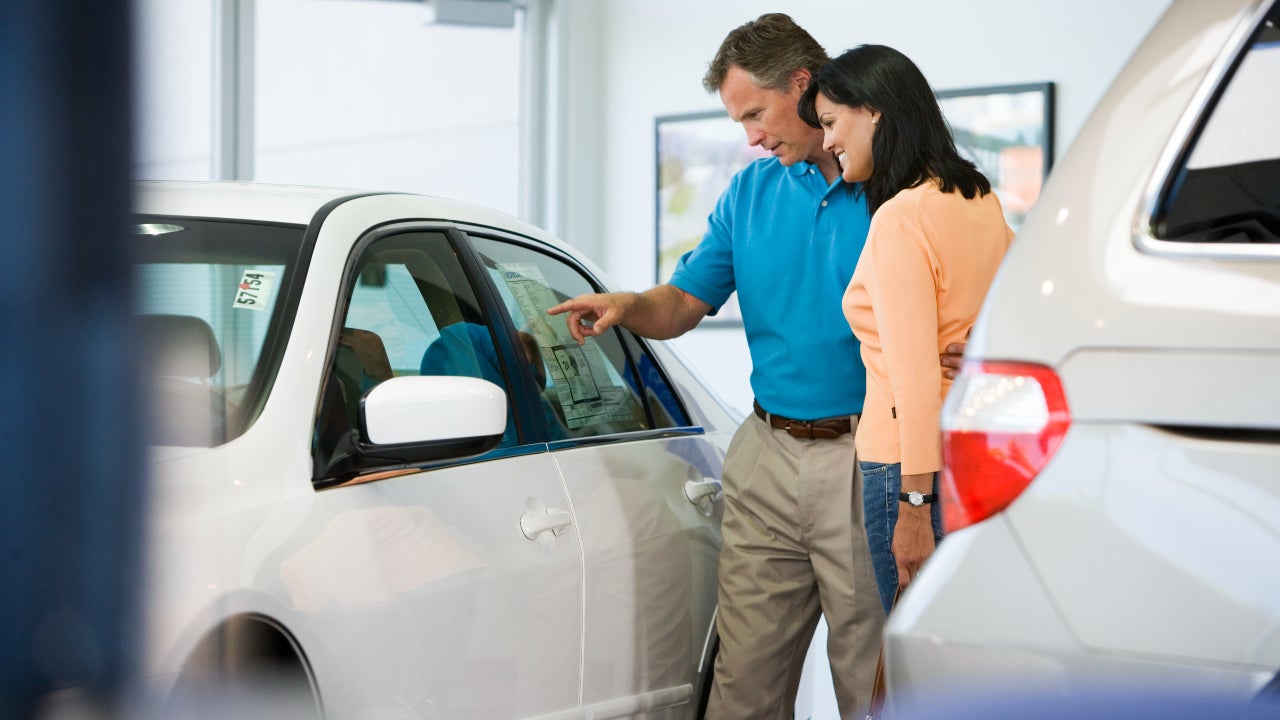Key takeaways
- Out-the-door (OTD) car pricing is the sum of all the costs you’ll pay for a car, including taxes and fees.
- The OTD price is higher than the manufacturer’s suggested retail price (MSRP) because it includes those additional costs.
- To get the best deal, negotiate the OTD price for a car rather than the monthly payment.
When it comes to buying a car — new or used — you are likely to be bombarded with a variety of different acronyms and terms. A common term dealers use is the out-the-door price, or OTD price, which differs from a car’s sticker price. The OTD price is the entire cost you will pay for a vehicle, including fees and sales tax.
Before heading out to buy your next vehicle, take the time to understand how OTD car pricing compares to other terms like MSRP. This can help you handle negotiations successfully and drive away with the best deal possible.
What is the out-the-door price?
The out-the-door price is a term that describes the total cost of the vehicle. It truly is what it says — it is the total cash price that you will pay for a car. This cost often includes a variety of extras, including some of the dealer’s expenses associated with the car. It is not unusual for OTD fees to include the costs of an extended warranty, dealer service fees, dealer handling fees, advertising fees and processing fees.
Knowing the OTD price is vital to negotiating — especially because you may be able to remove some of the common auto loan add-ons that may be included with your final price. It is also important to request this number before signing off on your new vehicle because the out-the-door price is typically higher than the sticker price.
However, your out-the-door price can also be affected by your trade-in and down payment. When you negotiate the total cost of the vehicle, request that these costs not be factored into the amount you pay. This way, you can see how much your vehicle will cost to finance before you put money down.
What does the out-the-door price cover?
The OTD price covers a range of costs that go into your new set of wheels, including:
- Price of the vehicle. This includes the MSRP or negotiated sales price of a car. The average price of a new car was $47,462 in March, according to Kelley Blue Book.
- Documentation fee. Dealerships often charge documentation fees to cover the cost of processing a vehicle’s paperwork.
- Sales tax. Sales tax is paid on the purchase price of the vehicle and varies by state. You will be responsible for paying sales tax regardless of if you buy a new or used car.
- Dealership preparation fees. Dealerships may also charge preparation fees to get the vehicle ready for you to drive off the lot. These fees often range from $100 to $500, but they may be negotiable.
- Dealer extras. Dealer extras or add-ons include things like gap insurance or an extended warranty. For many people, these can be purchased from a third party at a lower cost.
Out-the-door price vs. MSRP
The out-the-door price is the total cost of a vehicle, while the MSRP is just a suggested retail price.
The main price you will see when car shopping is the MSRP. This is usually the number on the vehicle window — the sticker price. The MSRP, or manufacturer’s suggested retail price, is the price that the vehicle manufacturer recommends. Although dealers do not always follow this price exactly, it is the starting point for negotiation.
But this number is much lower than the out-the-door price. Don’t be distracted by the number advertised. Instead, ask the dealer for the entire price you will be expected to pay — the out-the-door price. Negotiating based on that number, not the MSRP, is also important. The price difference will greatly impact your monthly cost, so calculate how much you can afford with an auto loan calculator.
How to find the out-the-door price when car shopping
You can do a few things to get an idea of the out-the-door price when shopping for a car.
-
Use an online OTD price calculator. Input the price of the car and your location, and the calculator will estimate things like document fees, sales taxes, and more. This won’t be completely accurate, but you can use it to get a sense of what you’ll pay.
-
Ask the dealership for the OTD price. If you find a car you like online, you could also simply call or email the dealership to request the OTD price for a vehicle you’re interested in. Some dealers might try to play games and force you to come to the dealership to discuss pricing, which could indicate you don’t want to work with that dealer anyway.
-
Negotiate. If you can get OTD pricing details from one dealer in your area, you can then use that information when negotiating with other dealerships. Use these numbers to get each dealer to compete for your business.
Negotiate out-the-door price, not monthly payment
One of the best tips for car shopping is to avoid thinking about monthly payments. Instead, look at the full price of the car. Dealers want you to focus on your car’s monthly payment, distracting you from the vehicle’s total cost.
Dealers can manipulate your monthly payment by extending the loan term. At the same time, the dealer may be tacking on extras that drive up the total cost out-the-door price of the vehicle. Whether you opt for dealer financing or a loan from a bank, the focus should be on the total you will pay at the end of the loan.
The payment is simply the amount you budget for each month. If you shop for preapproval for a car loan, you should know how much you can afford overall for a vehicle — and what you can expect your monthly payments to be based on that price.
Bottom line
Saving money at the dealership comes down to preparedness. Make sure you know what costs are included in the out-the-door price so that you are prepared to negotiate and eliminate any extras you don’t want to pay for.
In addition, apply for loan preapproval and shop around for different financing options. This will help you get the most competitive auto loan rates and determine how much you can afford.
Read the full article here





